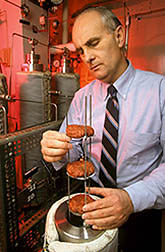Supercritical Fluid Fat Extraction
It can put low-fat burgers on your menu.
|
|
Meats like hamburger don't have to contain high fat and cholesterol, thanks to fat-extraction technology developed by ARS chemist Jerry W. King.
"With supercritical fluid extraction, we compress and heat a gas—usually carbon dioxide—so it becomes more dense and liquidlike," King explains. "This liquid CO2 can then pass through the meat and dissolve and pick up the meat's fat.
In experiments. King was able to extract an average of 4 grams of fat and 50 percent of available cholesterol from freeze-dried hamburger patties using the supercritical fluid extraction (SFE) process.
"As we take the CO2 back out," King says, "the dissolved fat comes with it. When the CO2 cools and decompresses, it turns back into a gas and the fat particles fall out of it. The same thing happens with the cholesterol in the meat."
SFE is already used by the food industry to remove caffeine from coffee and extract beer hops. King has specifically designed and developed SFE methods for food processing and chemical analyses. His research at the National Center for Agricultural Utilization Research at Peoria, Illinois, has made the United States a leader in the application of SFE for processing fat- and oil-containing agricultural products.
Although King's experiments involved preformed freeze-dried patties, SFE can also extract fat and cholesterol from fresh ground meat.
"But it might be less effective because of the fresh meat's water content," notes King. "The water in the meat acts as a buffer around the fat particles and can prevent the CO2 from getting to the fat."
King had done earlier work on using SFE to remove pesticides from food for analysis. After an article on that work appeared in Agricultural Research magazine [March 1993, pp. 12-13], several companies called King to inquire about the potential of SFE for removing fat and cholesterol from meat.
"Researchers have used this process to remove fat and cholesterol from other food products, such as milk, eggs, and some meat products," King points out.
"One advantage of using SFE to remove fat is that carbon dioxide is almost always used in the process, and CO2 poses no threat to the environment or human health," he says. "Since the fat that's removed in this way hasn't been touched by a chemical solvent, it can be put to some other use—even human consumption."
Meat processors may be inhibited by the high initial cost of SFE equipment, says King. But he believes SFE can fill a niche market for low-cholesterol, low-fat, freeze-dried meats.
King worked on the project in collaboration with Floyd K. McKeith, a meat scientist in the Department of Meat Science at the University of Illinois at Urbana. — By Linda Cooke, ARS.
Jerry W. King is at the USDA-ARS National Center for Agricultural Utilization Research, 1815 N. University St., Peoria IL 61604; phone (309) 681-6541, fax (309) 681-6686.
"Supercritical Fluid Fat Extraction" was published in the March 1995 issue of Agricultural Research magazine.







